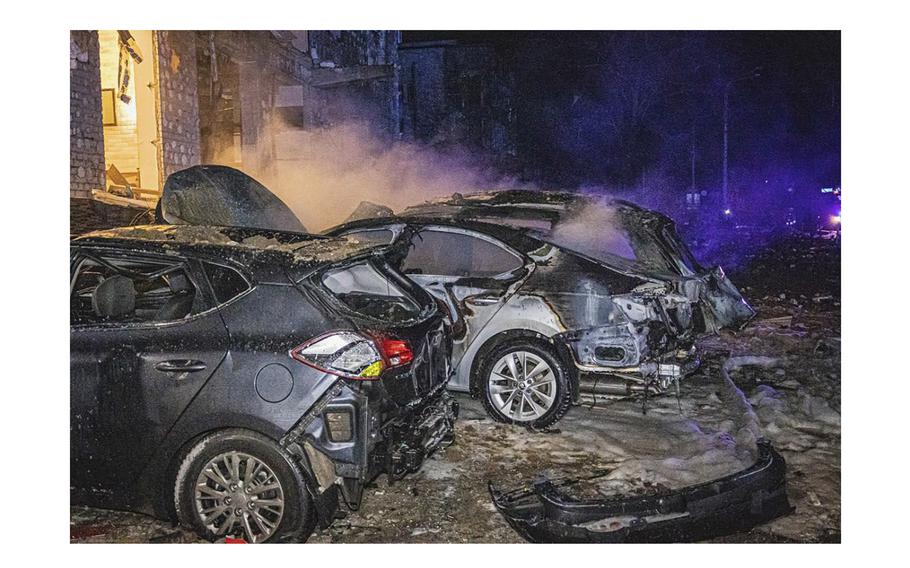
Cars burn after a Russian rockets attack that hit a hotel in Kharkiv, Ukraine, late on Jan. 10, 2024. According to reports on Saturday, Jan. 13, some 40 Russian missiles and drones of various types were launched nationwide and air defense said it shot down eight missiles. Another 20 or more “failed to achieve their targets due to active work of jamming,” Ukraine said. (Ukrainian Emergency Service)
(Tribune News Service) — Ukraine suffered its third large-scale aerial barrage of the new year, with the escalation of attacks from Kremlin forces coming at a time harsh weather leaves millions vulnerable to power outages.
Russian military jets fired Kinzhal ballistic missiles and cruise missiles at targets across the country early on Saturday, Ukrainian Air Force command said on Telegram.
Forty missiles and drones of various types were launched nationwide and air defense said it shot down eight missiles. Another 20 or more “failed to achieve their targets due to active work of jamming,” Ukraine said.
Explosions were heard in the northern region of Chernihiv, the western areas of Khmelnytskyi, Ivano-Frankivsk and Rivne, and in the Dnipropetrovsk and Poltava regions in central Ukraine as air defense was working, according to local authorities.
Russia’s defense ministry said in a statement that it had targeted Ukraine’s “military-industrial complex” with “major” hypersonic missiles and drone strikes, but offered no additional details.
After months of relatively few air strikes, Russia ramped up its bombardment campaign just before the new year. Since then it has fired hundreds of missiles at cities across Ukraine, including the capital, Kyiv, killing more than 45 and wounding dozens of civilians and damaging houses.
The air campaign coincides with the arrival of much colder weather, leaving millions of Ukrainians at risk from the loss of heat and electricity if power infrastructure is damaged. Temperatures were around -13 C (8.6 F) in central Ukraine and as low as -18 C (-0.4 F) in the east on Saturday morning, according to Weather Center.
Ukraine’s western neighbor Poland and allies scrambled jets as Moscow launched Saturday’s attack because debris of Russia’s missiles and drones have fallen on the European Union states’ territory on several occasions.
Russia launched the latest strikes hours after U.K. Prime Minister Rishi Sunak made a surprise visit to Kyiv to announce a new security commitment and a pledge of 2.5 billion pounds ($3.2 billion) of military aid next year.
Sunak and Ukrainian President Volodymyr Zelenskyy also signed a 10-year security cooperation agreement as Ukraine seeks to repel Russian forces who invaded almost two years ago.
Stephane Sejourne, appointed this week as France’s foreign minister in a cabinet reshuffle, is also expected to visit Kyiv this weekend.
Separately, Kyiv said preliminary evidence showed Moscow’s forces likely used missiles provided by North Korea in the Jan. 2 attack on Kharkiv, Ukraine’s second largest city.
South Korea’s defense minister said on Thursday that Pyongyang is looking to step up military cooperation with Russia by sending new types of tactical guided missiles in hopes of securing substantial aid to keep its economy afloat.
With assistance from Maciej Martewicz.
©2024 Bloomberg L.P.
Visit bloomberg.com
Distributed by Tribune Content Agency, LLC.